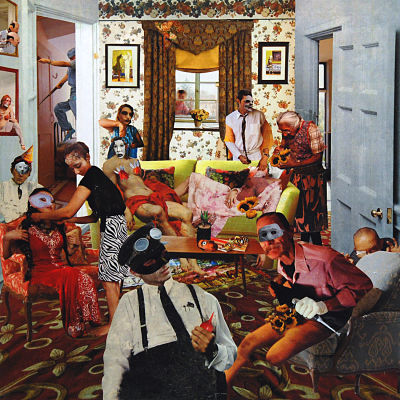
On the Face of It
November 2015. The term ‘face’ has roots in the verb ‘to see’. It’s the appearance, the look of the thing, the front, facade, form. While outward, it broadcasts the inward. A mask on the other hand prevents the seeing. Imposes a different look, a different seeing. And if you use the phrase, ‘on the face of it’, you’re meaning that what you see isn’t necessarily what you get. Seeing is not believing. Ask a barefaced liar about this. Or a woman putting on her face. Ask Carmen dell’Orefice.
I get caught up in watching this stunning woman, who at 85 or so is still modelling. Gorgeous face. Bones. She and other models talk about aging, of face lifts, air-brushing. Even so and with all this assistance, there is something of the truth that sneaks in and resists the repair. Something in her movements. The mouth.
The Mask is a short story written by Guy de Maupassant. A masquerade ball is held. One of the dancers, a thin man with a ‘pretty varnished mask, blonde moustache and wavy wig’ is drawing attention to himself with his frenzied and clumsy jigging. At some point he pitches forward falling to the floor. Carried out he is shortly attended to by a doctor who must first remove the mask, a rather complicated affair. Attached by a network of small metal wires to the wig, it covers his entire head, neck and shoulders, attached also to the collar of the shirt. Once all this has been cut away, a worn old man is revealed to everyone’s surprise, all having been quite certain this unskilled dancer had been a young man. The doctor finds his address and takes him home, met at the door by an old woman who is clearly annoyed but not overly concerned or surprised. Apparently this is a usual occurrence. Every Saturday night the old man downs a few absinthes for strength and then heads off to the masquerade with his pasteboard face. And why does he persist in this activity? So the young women will think he’s a young dandy and he can continue to believe he’s still capable of making conquests.
The beautiful face, the mask of youthfulness…there’s intention here. Dell’Orefice loses her savings in the Bernie Madoff Ponzi scheme and has to get back to work. The old dancer experiencing regret that he is no longer viable, finds a way to remain connected to his past identity.
There’s function. In my dream most characters are wearing masks that have to do with various roles they’ve played during their life-time. Some are ready to hand them off as they’d like to retire, but as no one is available to take over, they’re stuck with the masks..as well as the tasks.
While they have their uses, the very nature of the mask is to prevent a certain kind of seeing while offering another, and for that reason masks are not popular in some circles. Seekers of authenticity want the bare face for its expression of emotion. They want simple language. Maybe no language at all. Literal interpretations. Plain food. (Just kidding about the food).
At the same time, the bare face is not popular in other circles, or rather, isn’t even seen to exist. Take Art Spiegelman, author of the comic strip Maus. He says identity itself is a mask. It’s a constructed, fabricated object. In MetaMouse the protagonist is seen struggling to pull off his mask. By the third panel the mask is off and all that remains is the skeletal frame. Not even a face. The caption: the artist finally rids himself of the imposed mask of identity.
I admit to being partial to the idea of before and after. Under and over. But it’s all becoming slippery. Apparently our word ‘person’ comes from the Latin ‘persona’, which was originally the megaphone-mouthed mask used by actors in the open-air theatres of ancient Greece and Rome, the mask through (per) which the sound (sonus) came. So is it then a matter of the actor first, person second? Intention and then megaphone-mouth? In the beginning the word and later the flesh?
Perhaps, and in the end, a face is just another pretty facade. At any rate I’m heading to the dressing room to hang for a few minutes before my next scheduled appearance.